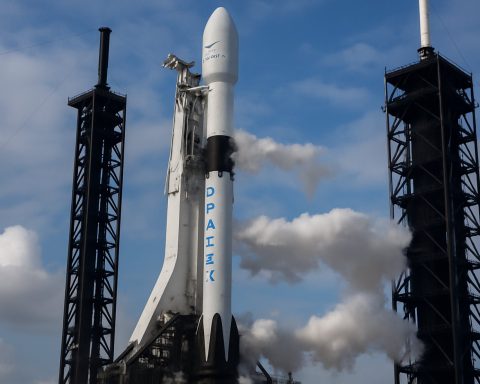- SpaceX’s Starship, aimed at ferrying humans to Mars, recently faced its second public failure, fueling debates on ambition versus accountability.
- The failed launch triggered scrutiny due to the involvement of taxpayer funding, raising questions about public investment in space exploration.
- Elon Musk, SpaceX’s CEO, is a controversial figure, blending innovation with spectacle, attracting both admiration and criticism.
- The explosion resulted in widespread social media discourse, highlighting societal reactions to Musk’s high-profile ventures.
- The incident reflects how technological achievements are now closely tied to personalities, with Musk’s influence framing these events as public spectacles.
- The dynamics of celebrity CEOs emphasize the challenges and opportunities in balancing public perception alongside technological pursuits.
The gleaming metal of SpaceX’s Starship towered on the launchpad, a symbol of ambition and hope for the future of space travel. But on Thursday, that gleaming promise was shattered—not just by flames and debris, but by waves of public discourse filled with both irony and intrigue. As the world’s most powerful rocket fractured in mid-air, pieces of its story rained across social media.
SpaceX’s Starship, a monumental engineering feat, was designed with a singular goal: to ferry humanity to Mars. Yet, the megarocket’s recent test flight marked its second consecutive public failure, raising questions about the juxtaposition of ambition and accountability. With a financial foundation intertwined with taxpayer dollars, every rocket launch becomes more than a technical endeavor; it becomes a stage for public scrutiny.
The explosion triggered a jarring sequence of events. The Federal Aviation Administration swiftly grounded flights across parts of Florida, a ripple effect of caution. Online, conversations unfolded with a mix of amusement and critical irony. Observers noted the paradox of SpaceX’s expenditures juxtaposed against Elon Musk’s parallel endeavors in advocating governmental austerity.
Musk, a luminary of the tech world, finds himself at the epicenter of both admiration and criticism—a modern figure shaped by the relentless spotlight of social media. His ventures, stretching from electric cars to cryptocurrencies like DOGE, often blur the lines between innovation and spectacle. In a society grappling with economic disparities, his visibility casts shadows that many relish when adversity strikes.
This collision of celebrity and industry isn’t novel, but Musk embodies it in a uniquely profound way. The viral reactions to SpaceX’s setbacks underscore a societal undercurrent where watching a titan stumble serves as a vicarious rebalancing of perceived injustices. It’s a public theater where cheers and jeers mingle amidst the digital chorus, each reaction revealing nuanced layers of collective sentiment.
Historically, technological breakthroughs have been met with awe. Yet, in contemporary times, fame personalizes progress, shifting the narrative towards personalities rather than solely achievements. Elon Musk’s larger-than-life persona transforms SpaceX launches into spectacles of not just scientific curiosity but also social commentary. His presence turns engineering marvels into symbols contested in the court of public opinion.
As the dust of the recent Starship trial settles, we’re left pondering a curious reality: the allure and peril of being a celebrity CEO. Musk’s notoriety acts as a double-edged sword—fueling SpaceX’s global recognition while simultaneously inviting intense scrutiny. The next chapter of SpaceX’s journey isn’t just about rockets; it’s about navigating the complex landscape of public perception.
In a world where ambition soars skyward, our gaze inevitably turns to the figures pioneering such flights. Perhaps it’s this blend of aspiration and human fallibility that captivates us. Whether success or failure, the shared journey of exploration continues, waiting for the next countdown, the next launch, and the next defining moment in the stars.
The Unstoppable Rise and Fall: What SpaceX’s Starship Crash Means for the Future of Space Travel
The Aftermath of SpaceX’s Starship Mishap: Insights Beyond the Headlines
SpaceX’s recent Starship test flight mishap has ignited a blaze of public discourse, extending beyond the confines of technical assessment into realms of social, economic, and environmental concerns. Starship, envisioned as humanity’s vessel to Mars, spectacularly exploded mid-flight during its second public test, marking a significant setback for Elon Musk’s ambitions. This incident not only reflects on SpaceX but also touches upon the broader themes of innovation, accountability, and celebrity influence.
Behind the Scenes: Why the Starship Program Matters
Real-World Use Cases
1. Mars Colonization: Starship is designed to transport humans to Mars, supporting aspirations for extraterrestrial colonization.
2. Satellite Deployment: Beyond crewed missions, Starship aims to significantly cut the costs of deploying satellite networks.
3. Space Tourism: SpaceX plans to leverage Starship for commercial passengers, opening new revenue streams.
Key Features and Specs
– Capacity: Starship is intended to carry up to 100 passengers or 150 tons of cargo.
– Reusability: Each Starship is fully reusable, aiming to drastically lower costs associated with space travel.
– Specifications: Standing at 394 feet tall, Starship is the tallest rocket ever built, with a thrust capability of 16 million pounds, making it the world’s most powerful rocket.
Controversies & Limitations
1. Cost Overruns: Development of Starship has been partially funded by taxpayers, leading to debates about public investment in private space endeavors.
2. Environmental Impact: Rocket launches contribute to carbon emissions and potential ozone layer depletion, raising environmental concerns.
3. Safety Concerns: The repeated failures introduce questions on the efficacy and safety of large-scale manned missions.
Market Forecasts & Industry Trends
The emergent space exploration industry is expected to reach $1 trillion in value by the 2040s, driven by technological advancements and new business models. Space tourism, satellite deployment, and off-earth resource mining are poised as primary market drivers.
Competitors & Comparisons
– Blue Origin: Jeff Bezos’s venture focuses on space tourism with its New Shepard rocket.
– Arianespace and ULA: Collaborating with governmental clients, these players offer traditional launch services.
Insights & Predictions
– Increased Government Scrutiny: Expect tighter regulations as public safety and investment come into sharper focus.
– Tech Innovation Acceleration: Failures often provide data leading to rapid technological progress.
– Public Perception: Navigating public relations will become crucial for securing ongoing support and investments.
Quick Tips and Recommendations
– For Future Astronauts: Stay informed about safety developments and training programs.
– For Investors: Diversify portfolios; consider space-related ETFs for exposure.
– For Enthusiasts: Engage in public forums and educational events to better understand the nuances of space travel technology.
Actionable Steps for Improvement
SpaceX must prioritize transparency in its developmental processes and engage more with the regulatory bodies to ensure the safety and viability of future launches. Enhancing their communication strategy to include detailed explanations of setbacks and advancements will likely bolster public and investor confidence.
For further details, explore more on SpaceX and stay updated on industry trends.
This event serves as a reminder that the rocky road toward space exploration is as much about nurturing innovation as it is about managing human expectations and environmental responsibilities. As we watch with bated breath, the sky remains not a limit, but the beginning of our celestial voyage.










